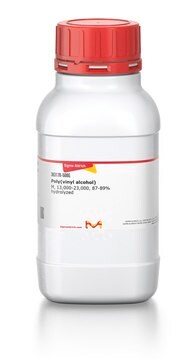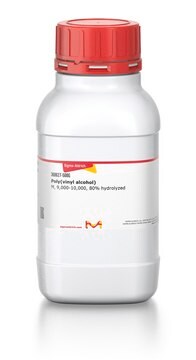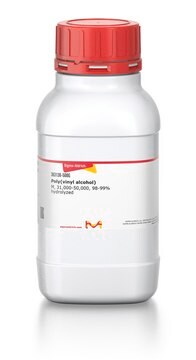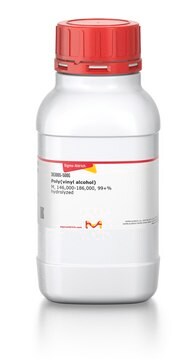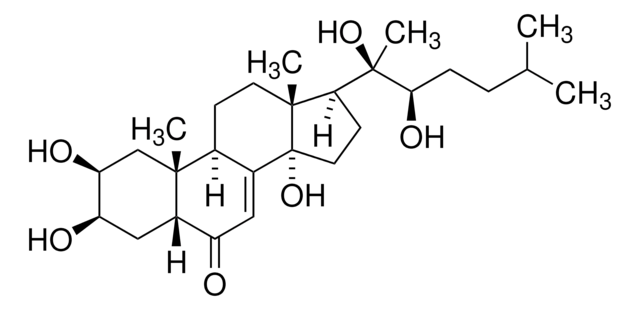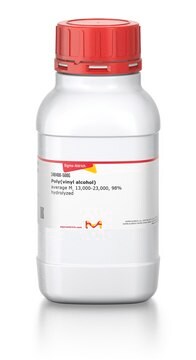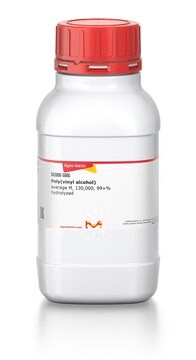P8136
Poly(vinylalkohol)
87-90% hydrolyzed, average mol wt 30,000-70,000
Synonym(e):
PVA, PVAl, PVOH, Poly(Ethenol)
Anmeldenzur Ansicht organisationsspezifischer und vertraglich vereinbarter Preise
Alle Fotos(2)
About This Item
Lineare Formel:
[-CH2CHOH-]n
CAS-Nummer:
MDL-Nummer:
UNSPSC-Code:
12352104
NACRES:
NA.21
Empfohlene Produkte
Qualitätsniveau
Form
powder
Mol-Gew.
average mol wt 30,000-70,000
Viskosität
4-6 cP, 4 % in H2O(20 °C)(lit.)
Löslichkeit
H2O: soluble
InChI
1S/C2H4O/c1-2-3/h2-3H,1H2
InChIKey
IMROMDMJAWUWLK-UHFFFAOYSA-N
Suchen Sie nach ähnlichen Produkten? Aufrufen Leitfaden zum Produktvergleich
Anwendung
Poly(vinyl alcohol) has been used:
- in in vitro production (IVP) of bovine embryos
- oocyte recovery and in vitro maturation
- as a macromolecular component in basal cultured medium
Biochem./physiol. Wirkung
Poly(vinyl alcohol) (PVA) is a polyhydroxy polymer, soluble in water. PVA is known to possess high mechanical strength, biocompatibility and non-toxicity. Hence, it serves as a biomedical implant material. Polymerization of vinyl acetate to poly (vinyl acetate), which is then hydrolysed to form PVA. Its application is observed in drug delivery systems, wound dressing, dialysis membranes, artificial skin, surgical repairs and cardiovascular devices.
Lagerklassenschlüssel
11 - Combustible Solids
WGK
WGK 1
Persönliche Schutzausrüstung
Eyeshields, Gloves, type N95 (US)
Hier finden Sie alle aktuellen Versionen:
Besitzen Sie dieses Produkt bereits?
In der Dokumentenbibliothek finden Sie die Dokumentation zu den Produkten, die Sie kürzlich erworben haben.
Kunden haben sich ebenfalls angesehen
In Vitro Developmental Competence of In Vitro-Matured Bovine Oocytes Fertilized and Cultured in Completely Defined Media
Keskintepe L and Brackett BG
Biology of Reproduction, 55, 333-339 (1996)
Nanostructured poly(vinyl alcohol)/bioactive glass and poly(vinyl alcohol)/chitosan/bioactive glass hybrid scaffolds for biomedical applications
Mansur HS and Costa HS
Chemical Engineering Journal, 137, 72-83 (2008)
Structure and applications of poly (vinyl alcohol) hydrogels produced by conventional crosslinking or by freezing/thawing methods
Biopolymers PVA Hydrogels Anionic Polymerisation Nanocomposites, 37-65 (2000)
Birth of Piglets Derived from Porcine Zygotes Cultured in a Chemically Defined Medium
Yoshioka K, et al.
Biology of Reproduction, 66(1), 112?119-112?119 (2002)
C Wrenzycki et al.
Human reproduction (Oxford, England), 16(5), 893-901 (2001-05-02)
Assisted reproduction technologies have made great progress during the last 15 years in most mammalian species, including humans. Growing evidence indicates that bovine pre-implantation development is a superior model for investigating early human development than the mouse. The purpose of
Unser Team von Wissenschaftlern verfügt über Erfahrung in allen Forschungsbereichen einschließlich Life Science, Materialwissenschaften, chemischer Synthese, Chromatographie, Analytik und vielen mehr..
Setzen Sie sich mit dem technischen Dienst in Verbindung.
